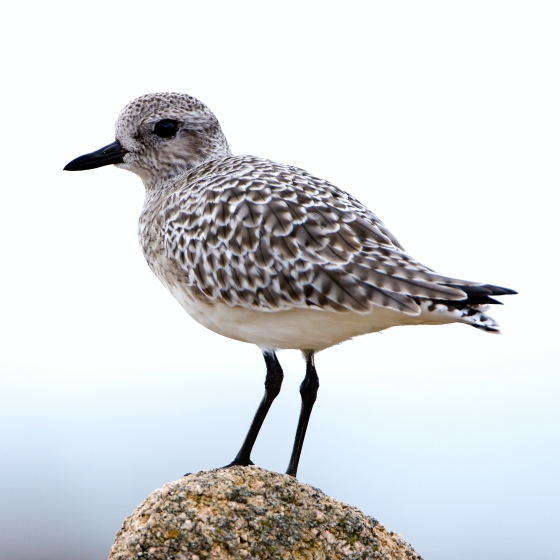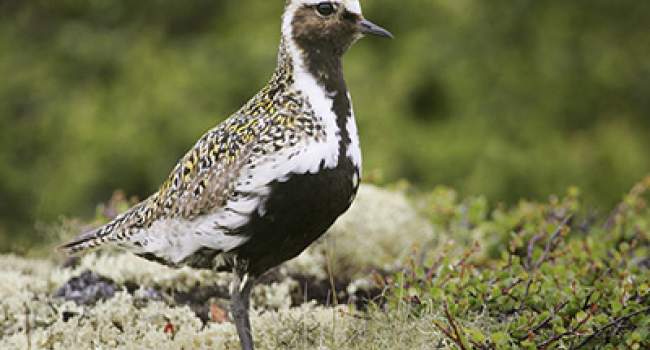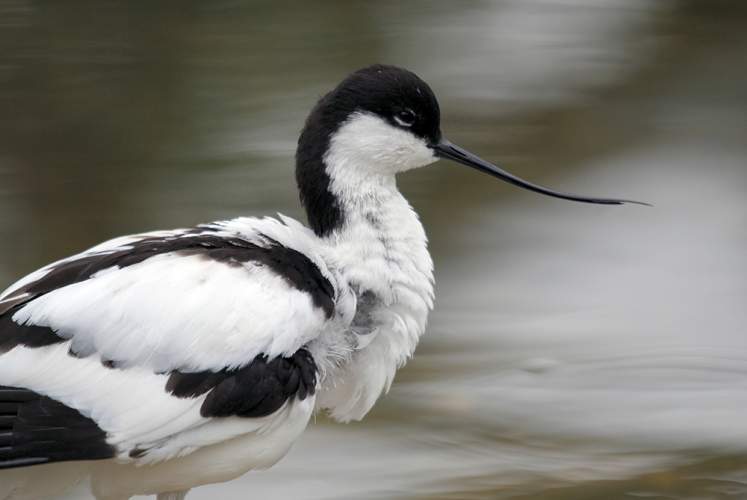Grey Plover
Pluvialis squatarola (Linnaeus, 1758)
GV
 GREPL
GREPL  4860
4860

Family: Charadriiformes > Charadriidae

Primarily a winter visitor to our coastal estuaries, its British name reflects its drab plumage at this time of year.
In summer, though, the Grey plover is more strikingly coloured and elsewhere it is known as the Black-bellied or Silver Plover. This was probably the last regularly occurring British species to have its breeding areas identified – not surprising given they are in the northernmost reaches of Siberia.
As with many Arctic-breeding waders, while some birds come to Britain for the winter, others continue their journey to spend the winter in western Africa. Unlike most birds, Grey Plovers often replace their primary feathers in two stages, moulting some before migrating and the remainder when they’ve completed their journey.
Identification
Grey Plover identification is often straightforward. The following article may help when identifying Grey Plover.
Identifying Grey Plover and Golden Plover

Can you tell the silver from the gold? Found around our coasts, wetlands and uplands Golden Plover is a beautiful medium-sized wader. Its cousin, Grey Plover, can be found around our coasts in most months of the year, causing a potential ID challenge. This ID workshop will help you to confidently separate the two species.
SONGS AND CALLS
Listen to example recordings of the main vocalisations of Grey Plover, provided by xeno-canto contributors.
Flight call
Alarm call
Call
Develop your bird ID skills with our training courses
Our interactive online courses are a great way to develop your bird identification skills, whether you're new to the hobby or a competent birder looking to hone your abilities.
Browse training coursesStatus and Trends
Population size and trends and patterns of distribution based on BTO surveys and atlases with data collected by BTO volunteers.
CONSERVATION STATUS
This species can be found on the following statutory and conservation listings and schedules.
POPULATION CHANGE
| UK winter population |
-35% decrease (1996/97–2021/22)  |
DISTRIBUTION
Grey Plovers are winter visitors and passage migrants to the UK and are widely distributed around the coasts, with a particular preference for areas with intertidal mud and sandflats. The breeding season map shows a scattering of spring and early autumn passage migrants and summering second calendar-year birds.
Occupied 10-km squares in UK
| No. occupied in winter | 533 |
| % occupied in winter | 18 |
European Distribution Map
DISTRIBUTION CHANGE
There has been little change in winter range since the 1980s.
| % change in range in winter (1981–84 to 2007–11) | +3.1% |
SEASONALITY
Grey Plovers are mostly winter visitors but a few birds summer on larger estuaries, and return migration can begin in late July.

Movement
Information about movement and migration based on online bird portals (e.g. BirdTrack), Ringing schemes and tracking studies.
RINGING RECOVERIES
View a summary of recoveries in the Online Ringing Report.
Foreign locations of birds ringed or recovered in Britain & Ireland

Biology
Lifecycle and body size information about Grey Plover, including statistics on nesting, eggs and lifespan based on BTO ringing and nest recording data.
SURVIVAL & LONGEVITY
View number ringed each year in the Online Ringing Report
Maximum Age from Ringing 
|
25 years 1 months 18 days (set in 2004) 
|
Typical Lifespan 
|
9 years with breeding typically at 2 year |
Adult Survival 
|
0.86  
|
Juvenile Survival 
|
0.63 (in first year) 
|
BIOMETRICS
Wing Length 
|
Adults | 199.5±6 | Range 188–209mm, N=253 |
| Juveniles | 195.3±5.3 | Range 185-203mm, N=115 |
Body Weight 
|
Adults | 243±27.7 | Range 200–290g, N=239 |
| Juveniles | 235±35.5 | Range 183–297g, N=105 |
Feather measurements and photos on featherbase 
CODES & CLASSIFICATION
Ring size 
|
D2 |
Field Codes 
|
2-letter: GV | 5-letter code: GREPL | Euring: 4860 |
For information in another language (where available) click on a linked name
Research
Interpretation and scientific publications about Grey Plover from BTO scientists.
PUBLICATIONS (1)

Consequences of population change for local abundance and site occupancy of wintering waterbirds
Wavering Waterbirds
Protected sites are assigned based on population statistics for vulnerable and endangered species. This new study using WeBS data shows that changes in population size can affect local abundance, and thus influence whether or not key targets are met for site protection.
Links to more studies from ConservationEvidence.com
- Rush cutting to create nesting patches for lapwings Vanellus vanellus and other waders, Lower Lough Erne RSPB reserve, County Fermanagh, Northern Ireland
- Population dynamics and reproduction of northern lapwings Vanellus vanellus in a meadow restoration area in central Sweden
- Restoration of degraded Molinia caerulea dominated moorland in the Peak District National Park Eastern moorlands, Derbyshire, England
Read more studies about Grey Plover on Conservation Evidence >
Would you like to search for another species?












Share this page